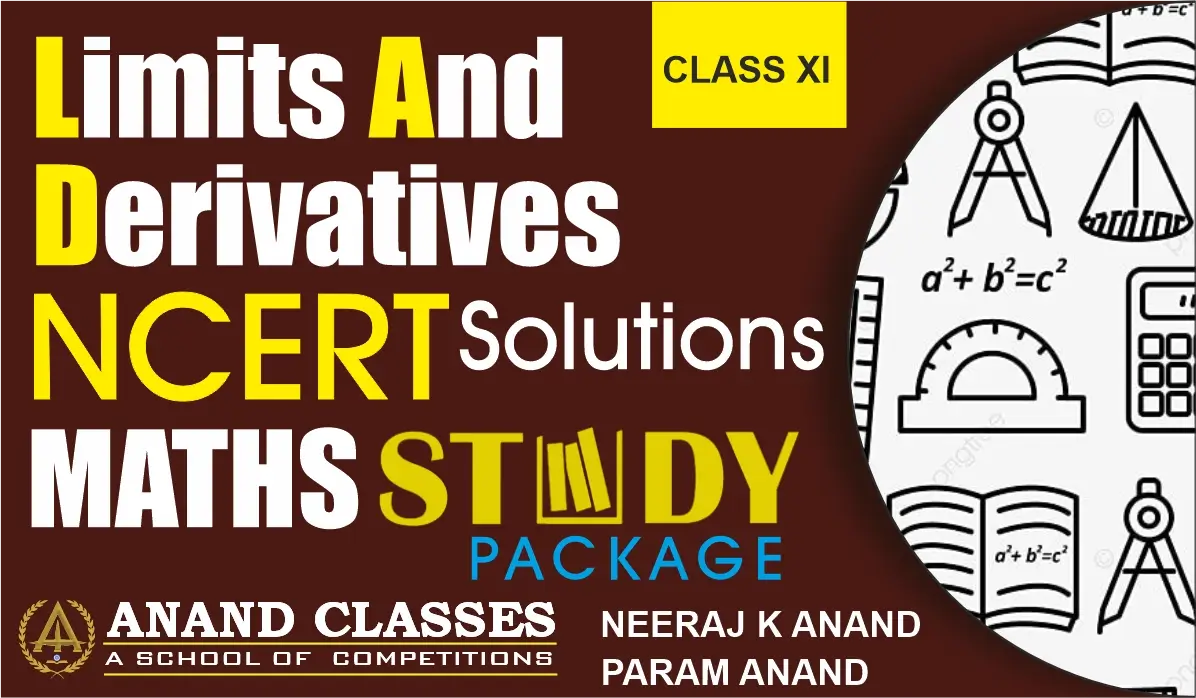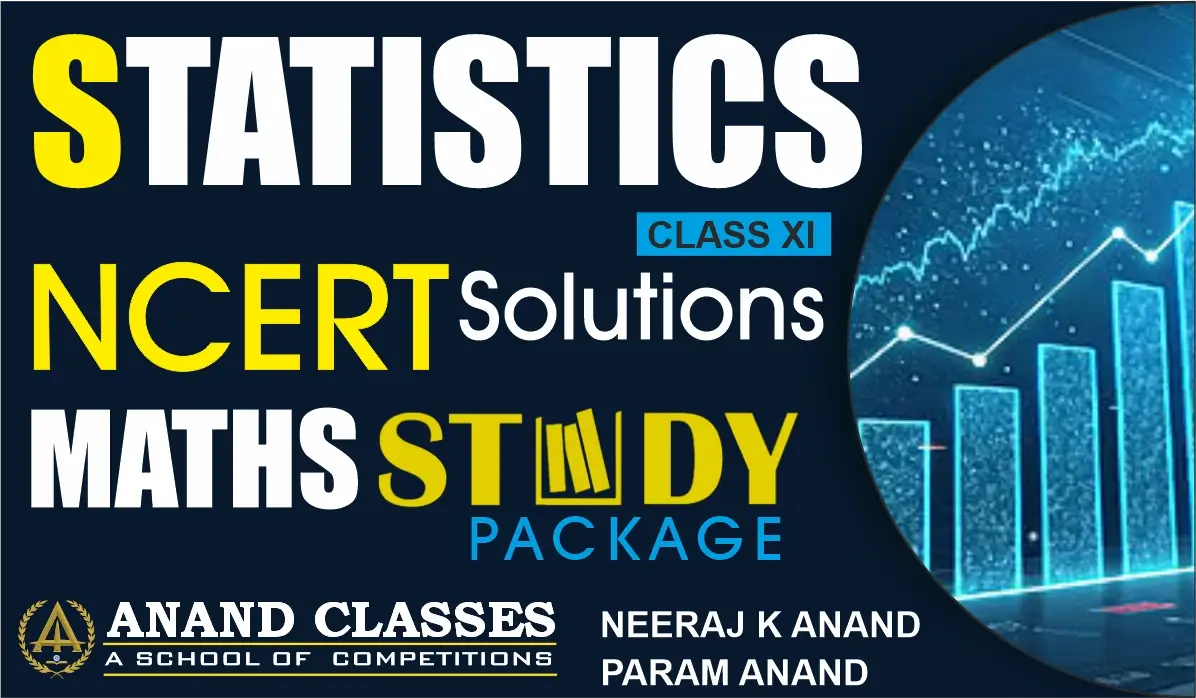Anand Classes presents comprehensive NCERT Solutions for Limits and Derivatives Exercise 12.2 Class 11 (Set-2) of Chapter 12 in PDF format, carefully prepared to help students understand fundamental calculus concepts with clarity. These step-by-step solutions follow the latest CBSE guidelines and NCERT textbook, making them perfect for Class 11 students aiming to strengthen their mathematical foundation and score high in exams. Each question is solved with detailed explanations to enhance conceptual understanding. Click the print button to download study material and notes.
NCERT Question 7.1 : For some constants $a$ and $b$, find the derivative of $(x – a)(x – b)$
Solution:
Let
$$f(x) = (x – a)(x – b)$$
Expanding, we get
$$f(x) = x^2 – (a + b)x + ab$$
Now, differentiating both sides with respect to $x$,
$$\frac{d}{dx} \big(f(x)\big) = \frac{d}{dx} \big(x^2 – (a + b)x + ab\big)$$
So,
$$f'(x) = \frac{d}{dx}(x^2) – \frac{d}{dx}((a + b)x) + \frac{d}{dx}(ab)$$
We know that:
- The derivative of $x^n$ is $n x^{n-1}$
- The derivative of a constant is $0$
Hence,
$$f'(x) = 2x – (a + b)(1) + 0$$
Simplifying, we get
$$f'(x) = 2x – (a + b)$$
$$
\boxed{f'(x) = 2x – a – b}
$$
Download detailed calculus notes and step-by-step derivative examples from Anand Classes, perfect for CBSE and JEE preparation.
NCERT Question 7.2 : For some constants $a$ and $b$, find the derivative of $(ax^2 + b)^2$
Solution:
Let
$$f(x) = (ax^2 + b)^2$$
Expanding the expression,
$$f(x) = (ax^2)^2 + 2(ax^2)(b) + b^2$$
$$f(x) = a^2x^4 + 2abx^2 + b^2$$
Now, differentiating both sides with respect to $x$,
$$\frac{d}{dx}\big(f(x)\big) = \frac{d}{dx}(a^2x^4 + 2abx^2 + b^2)$$
Therefore,
$$f'(x) = a^2\frac{d}{dx}(x^4) + 2ab\frac{d}{dx}(x^2) + \frac{d}{dx}(b^2)$$
Using the rule $\dfrac{d}{dx}(x^n) = n x^{n-1}$ and $\dfrac{d}{dx}(\text{constant}) = 0$, we get
$$f'(x) = a^2(4x^3) + 2ab(2x) + 0$$
Simplifying,
$$f'(x) = 4a^2x^3 + 4abx$$
$$
\boxed{f'(x) = 4a^2x^3 + 4abx}
$$
Get expertly formatted derivatives and calculus notes by Anand Classes, ideal for JEE, NEET, and CBSE students aiming for top results.
NCERT Question 7. For some constants $a$ and $b$, find the derivative of $$\dfrac{(x – a)}{(x – b)}$$
Solution:
Let
$$f(x) = \dfrac{x – a}{x – b}$$
We will differentiate this function using the quotient rule, which states that if
$$f(x) = \dfrac{u}{v}, \text{ then } f'(x) = \dfrac{v \dfrac{du}{dx} – u \dfrac{dv}{dx}}{v^2}$$
Here,
$$u = x – a \quad \text{and} \quad v = x – b$$
Now,
$$\dfrac{du}{dx} = 1 \quad \text{and} \quad \dfrac{dv}{dx} = 1$$
Substitute into the quotient rule:
$$f'(x) = \dfrac{(x – b)(1) – (x – a)(1)}{(x – b)^2}$$
Simplify the numerator:
$$f'(x) = \dfrac{(x – b – x + a)}{(x – b)^2}$$
$$f'(x) = \dfrac{(a – b)}{(x – b)^2}$$
$$
\boxed{f'(x) = \dfrac{a – b}{(x – b)^2}}
$$
Get concept-based derivative explanations and MathJax-formatted calculus notes from Anand Classes, trusted by CBSE and JEE toppers for mastering differentiation from first principles.
NCERT Question 8. Find the derivative of $\dfrac{x^n – a^n}{x – a}$ for some constant $a$.
Solution:
$f(x) = \dfrac{x^n – a^n}{x – a}$
Taking derivative both sides,
$$\frac{d}{dx}(f(x)) = \frac{d}{dx}\left(\frac{x^n – a^n}{x – a}\right)$$
Using quotient rule, we have
$$(\frac{u}{v})’ = \frac{uv’ – vu’}{u^2}$$
$$f'(x)=\left(\frac{(x-a)\frac{d}{dx}(x^n – a^n) – (x^n – a^n)\frac{d}{dx}(x – a)}{(x-a)^2}\right)$$
$$f'(x)=\left(\frac{(x-a)\left[\frac{d}{dx}(x^n) – \frac{d}{dx}(a^n)\right] – (x^n – a^n)(1)}{(x-a)^2}\right)$$
As, the derivative of $x^n$ is $nx^{n-1}$ and derivative of constant is $0$.
$$f'(x)=\left(\frac{(x-a)\left[(nx^{n-1}) – 0)\right] – (x^n – a^n)}{(x-a)^2}\right)$$
$$f'(x)=\left(\frac{(x-a)(nx^{n-1}) – x^n + a^n}{(x-a)^2}\right)$$
$$f'(x)=\left(\frac{(nx^{n-1}+1 – a^n x^{n-1}) – x^n + a^n}{(x-a)^2}\right)$$
$$f'(x)=\left(\frac{(nx^n – a^n x^{n-1}) – x^n + a^n}{(x-a)^2}\right)$$
NCERT Question 9.1 : Find the derivative of $(2x – \dfrac{3}{4})$
Solution:
Let
$$f(x) = 2x – \frac{3}{4}$$
Taking derivative both sides,
$$\frac{d}{dx}\big(f(x)\big) = \frac{d}{dx}\left(2x – \frac{3}{4}\right)$$
We know:
- Derivative of (2x) is (2)
- Derivative of a constant is (0)
Therefore,
$$f'(x) = 2 – 0$$
$$f'(x) = 2$$
NCERT Question 9.2 : Find the derivative of $(5x^3 + 3x – 1)(x – 1)$
Solution :
Let
$$f(x) = (5x^3 + 3x – 1)(x – 1)$$
Using product rule:
$$(uv)’ = u’v + uv’$$
Here,
$$u = 5x^3 + 3x – 1 \quad \text{and} \quad v = x – 1$$
So,
$$u’ = \frac{d}{dx}(5x^3 + 3x – 1) = 15x^2 + 3$$
$$v’ = \frac{d}{dx}(x – 1) = 1$$
Now apply product rule:
$$f'(x) = (15x^2 + 3)(x – 1) + (5x^3 + 3x – 1)(1)$$
Expand step-by-step:
$$(15x^2 + 3)(x – 1) = 15x^3 – 15x^2 + 3x – 3$$
So,
$$f'(x) = 15x^3 – 15x^2 + 3x – 3 + 5x^3 + 3x – 1$$
Combine like terms:
$$f'(x) = (15x^3 + 5x^3) + (-15x^2) + (3x + 3x) + (-3 – 1)$$
$$f'(x) = 20x^3 – 15x^2 + 6x – 4$$
Final Answer
$$\boxed{f'(x) = 20x^3 – 15x^2 + 6x – 4}$$
Top-quality maths solutions for boards and competitive exams by Anand Classes — perfect for smart learning and revision!
NCERT Question 9.3 : Find the derivative of $x^{-3}(5 + 3x)$
Solution :
Let
$$f(x) = x^{-3}(5 + 3x)$$
Apply the product rule:
$$(uv)’ = u’v + uv’$$
Here,
$$u = x^{-3} \quad \Rightarrow \quad u’ = -3x^{-4}$$
$$v = 5 + 3x \quad \Rightarrow \quad v’ = 3$$
Now substitute:
$$f'(x) = (-3x^{-4})(5 + 3x) + (x^{-3})(3)$$
Distribute terms:
$$f'(x) = -15x^{-4} – 9x^{-3} + 3x^{-3}$$
Combine like terms:
$$f'(x) = -15x^{-4} – 6x^{-3}$$
Factor if desired:
$$f'(x) = -3x^{-4}(5 + 2x)$$
Final Answer
$$\boxed{f'(x) = -15x^{-4} – 6x^{-3}}$$
or
$$\boxed{f'(x) = -3x^{-4}(5 + 2x)}$$
Score high in calculus with expert-style notes from Anand Classes — perfect for board exams and competitive preparation!
NCERT Question 9.4 : Find the derivative of $x^{5}(3 – 6x^{-9})$
Solution :
Let
$$f(x) = x^{5}(3 – 6x^{-9})$$
Expand first to simplify differentiation:
$$f(x) = 3x^{5} – 6x^{5} \cdot x^{-9}$$
$$f(x) = 3x^{5} – 6x^{-4}$$
Now differentiate term-by-term:
- Derivative of $3x^{5}$:
$$\frac{d}{dx}(3x^5) = 15x^4$$ - Derivative of $-6x^{-4}$:
$$\frac{d}{dx}(-6x^{-4}) = -6(-4)x^{-5} = 24x^{-5}$$
Therefore,
$$f'(x) = 15x^{4} + 24x^{-5}$$
You may also express it in a single fraction:
$$f'(x) = \frac{15x^{9} + 24}{x^{5}}$$
✅ Final Answer
$$\boxed{f'(x) = 15x^{4} + 24x^{-5}}$$
or
$$\boxed{f'(x) = \frac{15x^{9} + 24}{x^{5}}}$$
Upgrade your Mathematics preparation with clear derivative solutions — Anand Classes supports your success in JEE & CBSE exams!
NCERT Question 9.5 : Find the derivative of $x^{-4}(3 – 4x^{-5})$ using the product rule.
Solution :
Let
- $u = x^{-4}$
- $v = 3 – 4x^{-5}$
Then,
- $u’ = \frac{d}{dx}(x^{-4}) = -4x^{-5}$
- $v’ = \frac{d}{dx}(3 – 4x^{-5}) = 0 – 4(-5)x^{-6} = 20x^{-6}$
Using the product rule:
$$\frac{d}{dx}(uv) = u’v + uv’$$
Substituting values:
$$f'(x) = (-4x^{-5})(3 – 4x^{-5}) + (x^{-4})(20x^{-6})$$
Now expand and simplify:
First part:
$$(-4x^{-5})(3) = -12x^{-5}$$
$$(-4x^{-5})(-4x^{-5}) = +16x^{-10}$$
Second part:
$$20x^{-4-6} = 20x^{-10}$$
Combine like terms:
$$f'(x) = -12x^{-5} + 16x^{-10} + 20x^{-10}$$
$$f'(x) = -12x^{-5} + 36x^{-10}$$
✅ Final Answer
$$\boxed{f'(x) = -12x^{-5} + 36x^{-10}}$$
Strengthen your calculus skills with Anand Classes — ideal for JEE, NEET, and CBSE students aiming for top marks!
NCERT Question 9.6 : Find the derivative of
$$f(x) = \frac{2}{x+1} – \frac{x^2}{3x – 1}$$
Solution:
Differentiate term-by-term.
For the first term:
$$\frac{2}{x+1} = 2(x+1)^{-1}$$
$$\frac{d}{dx}\left[ 2(x+1)^{-1} \right] = -2(x+1)^{-2}$$
So,
$$\frac{d}{dx}\left[\frac{2}{x+1}\right] = -\frac{2}{(x+1)^2}$$
For the second term, use the quotient rule:
$$\left(\frac{p}{q}\right)’ = \frac{p’q – pq’}{q^2}$$
Here,
$$p = x^2 \Rightarrow p’ = 2x$$
$$q = 3x – 1 \Rightarrow q’ = 3$$
Apply the rule:
$$\frac{d}{dx}\left[\frac{x^2}{3x – 1}\right] = \frac{(2x)(3x – 1) – (x^2)(3)}{(3x – 1)^2}$$
Expand:
$$= \frac{6x^2 – 2x – 3x^2}{(3x – 1)^2}$$
$$= \frac{3x^2 – 2x}{(3x – 1)^2}$$
$$= \frac{x(3x – 2)}{(3x – 1)^2}$$
Final Answer
$$f'(x) = -\frac{2}{(x+1)^2} – \frac{x(3x – 2)}{(3x – 1)^2}$$
Master derivatives step-by-step with Anand Classes — ideal for Class 11–12 and JEE aspirants! 🚀


